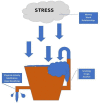Chronic Stress, Exercise and Cardiovascular Disease: Placing the Benefits and Risks of Physical Activity into Perspective
- PMID: 34574843
- PMCID: PMC8471640
- DOI: 10.3390/ijerph18189922
Chronic Stress, Exercise and Cardiovascular Disease: Placing the Benefits and Risks of Physical Activity into Perspective
Abstract
Chronic stress, which has been exacerbated worldwide by the lingering COVID pandemic, has been strongly linked to cardiovascular disease (CVD). In addition, autonomic dysregulation via sustained sympathetic activity has been shown to increase the risk of arrhythmias, platelet aggregation, acute coronary syndromes and heart failure. Fortunately, effective coping strategies have been shown to attenuate the magnitude of hyperarousal associated with the stress response, including moderate-to-vigorous lifestyle activity and/or structured exercise. A good-to-excellent level of cardiorespiratory fitness also appears to be highly cardioprotective. These beneficial effects have been substantiated by numerous studies that have evaluated the levels of stress reactivity and stress recovery in physically active individuals versus matched sedentary controls, as well as before and after exercise interventions. On the other hand, unaccustomed strenuous exercise in habitually sedentary persons with underlying CVD is associated with a disproportionate incidence of acute cardiac events. Moreover, extreme exercise regimens appear to increase coronary calcification and the likelihood of developing atrial fibrillation. This review summarizes these relations and more, with specific reference to placing the benefits and risks of physical activity into perspective.
Keywords: acute myocardial infarction; atherosclerotic cardiovascular disease; atrial fibrillation; chronic stress; coronary artery calcium; hypertrophic cardiomyopathy; physical activity; sudden cardiac death.
Conflict of interest statement
The authors declare no conflict of interest.
Figures






References
Publication types
MeSH terms
LinkOut - more resources
Full Text Sources
Medical

